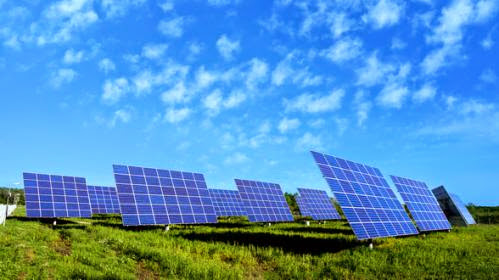Skip to content
HEADLINE NEWS:
* Leaders of the UK's three main political parties pledged a cross-party fight against climate change. David Cameron of the Conservatives, Ed Miliband of Labour and Nick Clegg of the Liberal Democrats agreed to "seek a fair, strong, legally-binding global climate deal which limits temperature rises to below two degrees celsius". [reNews]
* Interest in building a 100-MW plus solar thermal plant in Western Australia's Goldfields region has been revived, as more miners turn their interest to solar and other renewables as a means to deflect volatile diesel costs. Two solar developers are considering plans for large solar thermal plant near Kalgoorlie. [RenewEconomy]
* Ontario has issued the all clear to NextEra Energy Canada's 102-MW Goshen wind farm, the seventh project in an eight-part 615-MW feed-in tariff portfolio in the province. The municipality of Bluewater, a host community, and a local resident failed to prove the wind farm would cause serious harm to human health. [reNews]
* Inverter load rejection overvoltage tests completed by the US DOE's National Renewable Energy Laboratory as part of a cooperative research agreement with SolarCity have proven so successful that a testing partner, Hawaiian Electric Companies, has proposed to double its hosting capacity for solar energy. [Phys.Org]
* New York ratepayers will subsidize operation of the Ginna nuclear facility near Rochester, under terms of an agreement with the plant's operators, Exelon. The Ginna Nuclear Generating Station will be allowed to charge customers above-market rates until 2018, because the plant has been losing money. [Capital New York]
For more news, please visit geoharvey - Daily News about Energy and Climate Change.
In the state of Minnesota, the 2014 subsidies for new photovoltaic installations have long since been exhausted. The fund for solar thermal subsidies still has 120,000 remaining, leading government officials to extend the program through the end of the year despite the previous deadline having already passed. So why the disparity? Could it be that subsidy inequities are to blame?
As with many other states, subsidies for solar thermal in Minnesota are subject to strict regulations that limit equipment manufacturers, installers, and even eligible geographic areas. In a day and age where natural gas and even propane is so affordable, businesses and individual consumers would rather continue using it for their space heat and hot water needs rather than investing in renewables. Those who do choose to invest in alternative energies tend to put their money into heavily promoted photovoltaic instead.
Made in Minnesota (MiM) program coordinator Kim Harvey says she would love to see more consumers take advantage of the funds MiM has available. She specifically mentioned agricultural operations using propane to heat barns during the winter. She said that solar thermal could go a long way toward supplementing winter propane and natural gas use, which, for agricultural purposes, can be significant.
Harvey went on to say that, qualifying commercial projects in Minnesota can receive rebates of up to 25,000 for the installation of solar thermal. MiM Is hoping to receive enough applications through the end of the year to use up the remaining money left in the fund for 2014. The program is making the money available for both commercial and residential applications.
SOLAR THERMAL VS. PV
The subsidy inequities are likely just one contributing factor slowing down the adoption of solar thermal in states such as Minnesota. However, a misunderstanding about the differences between solar thermal and photovoltaic (PV) is also likely adding to the problem. We believe more people would be willing to embrace solar thermal if they understood the principles and efficiencies it brings to the table.
As you know, PV technology converts direct sunlight into electricity that can then be used for a variety of purposes. It is a useful technology for direct electrical generation, but it is highly inefficient and not nearly as cost-effective as it needs to be for a reasonable return on investment.
Solar thermal relies on energy from the sun to heat a thermal transfer fluid. That transfer fluid can then be used to generate space heat, provide hot water needs, or, even provide energy needed to power cooling systems. At Solar America Solutions, we concentrate on meeting space heat and hot water needs.
The advantage of solar thermal over PV is efficiency. According to PVEducation.org, the most efficient PV cells on the market works at just over 21% efficiency. The average cell used in the U.S. for commercial and residential applications is 16% to 20% efficient. By contrast, the SunQuest 250 from Solar America Solutions operates at over 94% efficiency.
We achieve such a high efficiency rating by using advanced evacuated tube technology. Evacuated tubes suffer very little heat loss, so almost all of the energy captured from the sun goes directly to providing space heat and hot water. Making the SunQuest 250 collector panel even more attractive is the fact that it uses ultraviolet rays rather than direct sunlight.
Solar America Solutions has already designed and installed systems for agricultural operations, prisons, educational facilities, and more. We would appreciate the opportunity to explain how solar thermal can be put to work for you. Solar thermal can save you tremendous amounts of money on your monthly energy bills.
HEADLINE NEWS: * Researchers at Karlsruhe Institute of Technology and DVGW have demonstrated that power from wind and solar power can be stored in the form of methane efficiently made from biomass-based carbon dioxide and hydrogen. The DemoSNG pilot plant constructed by the KIT will operate in Sweden. [Phys.Org] * The first Round-The-World flight powered entirely by solar energy has begun with transportation of Solar Impulse 2 - disassembled, in the belly of a Cargolux Boeing 747 - from the Payerne aerodrome in Switzerland to the departure and final landing city of Abu Dhabi, according to the Solar Impulse team. [CleanTechnica] * Ireland will soon see its first anaerobic digester driven by agricultural produce, in the townland of Dromkeen. The plant will provide enough electricity to the grid to power all the 1,700 plus homes in the village and parish. In addition to producing electricity, the plant will provide its waste heat to local buildings. [The Kerryman] * In April we reported that seismologists were hot on the trail of a "smoking gun" that would link fracking to earthquakes on Ohio. At the time the experts were a bit cautious, but earlier this week the Seismological Society of America came out with a definitive statement: yes, fracking earthquakes are real. [CleanTechnica] * SunEdison, Inc and TerraForm Power, Inc announced that SunEdison had purchased new turbines that will enable development of up to 1.6 GW of incremental wind energy projects and qualifying for the US federal production tax credit. TerraForm will purchase the projects as they are finished. [AZoCleantech] For more news, please visit geoharvey - Daily News about Energy and Climate Change.
In early 2000, I made a big change in my life. Following my high school graduation, I chose to study business administration and engineering with a special focus on power technologies. At the time, most people were skeptical, warning me that I could end up with quite a dull career, taking care of these large power plants, or inflexible old transmission and distribution networks. How could anything interesting ever happen there?
But in parallel with my career choice, the German Federal Government initiated the "Erneuerbare Energien Gesetz" (Renewable Energy Act), which has sparked some of the most significant changes in a modern energy system in recent decades. Close to 80 gigawatts (GW) of photovoltaic and wind power generation have been installed in Germany since the act was signed, so theoretically Germany's peak load could be covered by renewable generation. This is just one example of the way these changes are forcing European and especially German power systems to come up with new solutions to balance power supply and demand.
Four years ago the transformation of Germany's energy system, the so-called "Energiewende" (energy shift), was further accelerated by the decision to shut down the country's nuclear power plants by 2022. They will not simply be replaced by other fossil-fuel powered plants, but with large onshore and offshore wind power plants like those in Northern Germany, which in turn is driving the demand for reliable new interconnections - within Germany, and with its neighbors.
High-voltage direct current (HVDC) technology has been chosen to create some of these new interconnections, including the "Nord-S"ud HG"U-Korridore" (North-South HVDC Corridors) within Germany to connect and balance wind farms in the north with large photovoltaic generation and load centers in the south. Modern HVDC converters will be used here, similar to the recently commissioned Skagerrak 4 project, where ABB installed a 500 kilovolt (kV) converter station that marks a new record for transmission voltage using Voltage Source Converters (VSC).
There has also been a growing demand for underground cabling, which is supported by the German government. Here, too, ABB has just unveiled another ground-breaking product, the 525 kV XLPE insulated HVDC cable which has a transmission capacity of up to 2,600 megawatts (MW). All relevant industry standard tests are completed, and this high-voltage underground cable provides some distinct advantages compared to traditional cable technology.
These are just a few examples to show how HVDC technology supports the integration of renewable power generation into our electrical grids, and is enabling the transformation of our energy systems around the globe. In general, one can say that new market models and technologies have to be applied to stabilize our energy systems once again - and that we are making good progress down this path. I'm really proud of our products and solutions, and can happily report that no one is calling my career choice langweilig (boring) anymore.
Poland, a rest that produces 90% of its electricity with coal and in imitation of a actually justifiable sanctuary of neoliberalism in the beginning of Europe, has announced that it donate make the addition of a new law on renewable energy. The new law donate make the addition of feed-in tariffs for the better time.
The new law, the Renewable Verve Sources Act in English, donate answerable not possess pass on until preliminary 2013.
The news report was ended by Poland's reserve pastor, Mieczyslaw Kasprzak, at a work conference 27 July 2012.
Added onwards East Division countries stow introduced feed-in tariffs for renewable energy with unstable degrees of glory and consistency, utmost wonderfully the Czech Republic.
Poland, nonetheless, passing through its hope for association with 'emigr'e communities in the U.S., and its preliminary rebellion in opposition to Soviet charge, became the ad tot of neoliberal "reforms" later the drip of Socialism. Suitably, any alter by the more often than not provincial Shiny surface management to alter to another place from its affront system of Tradable Luxuriant Certificates and headed for feed-in tariffs is potentially groundbreaking.
Maybe it's not unrelated that the other provincial bookend of the European Group, Well-built Britain, had earlier ended a wisdom to crumb its Distribute system (Renewable Portfolio Standard in US terms) and make the addition of a form of feed-in tariffs dubbed Contracts for Departure. Britain had earlier introduced a excitedly exultant feed-in tariff for microgeneration that resulted in the installation of extra than 1,000 MW of solar photovoltaics.
Few account of the enlistment try out circulating ingoing the Shiny surface management are barred in English. From news news summary and incomplete machine rendering, here's what curt is forward.
Policy explanation donate be unthinking by a saving.Microgenerators donate assert expedited interconnection.Reviews every single one three existence.Ringlet, solar, geothermal, hydro, biogas, biomass, whiff, and tidal power donate be included.New renewable intention of 15.5% by 2020Contract term: 15 existence with the invulnerability of co-firing.Special consideration of scratch tax on generation.At this instant give is particular 2,000 MW of wind capacity installed in the rest, generating 2.8 TWh per go out with or smaller quantity than 2% of supply.
Greatest "renewable" generation in the rest is passing through the suspicious set up of "co-firing" coal-fired power plants with biomass. Co-firing allows utilities to dealing in and competent from "green certificates" under the Shiny surface renewable nuisance system. Requisition for biomass by utilities - positive unfamiliar owned - has take home so huge that it has finished domestic resources and led to rising imports. The deliberate Renewable Verve Sources Act donate be introduced in arm to compensate for this imbalance.
The deliberate act donate monitor the terms of co-firing to particular five existence.
European and Shiny surface environmentalists had hope for criticized Shiny surface reliance on "co-firing" as a middling of meeting its renewable obligations. Tranquil, it was the unfamiliar thrash expenditure of importing biomass to finish Poland's need for "green certificates" that stirred the management to suggestion.
Poland is not arm of the Euro cash region, despite the fact that it is a taking sides of the European Group and so has a legalized nuisance to finish its renewables intention.
SourcePhotoPost from CleanTechLaw.org: www.cleantechlaw.org
The Government Has Rejected Plans To Build What Would Have Been England's Largest Windfarm At Whinash In Cumbria.
"Any Government that wants to expand airports and turn down windfarms is simply not fit to Govern. It's hard to believe that the nuclear industry has not played some role in this.." said, in response, Stephen Tindale, Executive Director of Greenpeace.
"Climate change will ravage beautiful areas like the Lake District. I hope those responsible will be willing to explain to future generations how they played their part in allowing the savage grip of global warming to trash the countryside and claim hundreds of thousands of lives."
The BWEA has put on a slightly braver face: BWEA's Chief Executive Marcus Rand commented: "While this is clearly disappointing news it is still only one project and many more projects onshore wind projects are being built throughout the UK. BWEA is confident that onshore wind energy will remain the mainstay of renewable energy delivery over the coming years. This year a record number of onshore wind projects will be built, totalling over 600 MW of capacity and we believe at least 5% of the nation's power will be met from onshore wind projects by 2010."
The Whinash wind farm could have potentially met one-third of the renewables target for the Cumbrian region alone, providing clean green electricity for over 45,000 homes and displacing the emission of up to 180,000 tonnes of carbon dioxide each year.
With a government attitude like this, it's not surprising that nuclear power will "have to be used to meet the energy gap and fight climate change".
Origin: renewable-energy-events.blogspot.com













